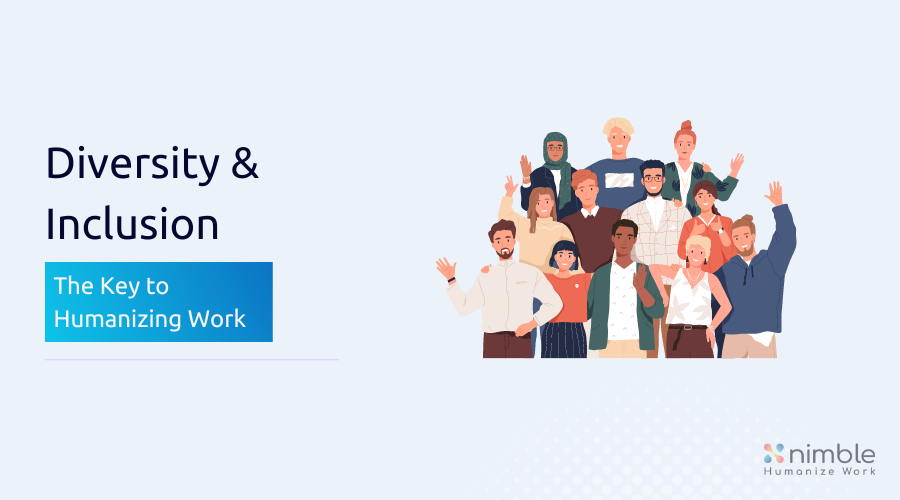- Why Nimble?
- Products
_____________________
_____________________
- Solutions
- Customers
- Resources
- Login
- Try Nimble for Free
- Why Nimble?
- Products
_____________________
_____________________
- Solutions
- Customers
- Resources
- Login
- Try Nimble for Free
Navigate to
The Crucial Relation: Diversity & Inclusion and Humanizing Work
- 8 mins read
- By Carlos Schults

While DEI — diversity, equity & inclusion — has gained a lot of relevance for companies over time, humanizing work is a more recent concept.
The relation between diversity and inclusion and humanizing work is not always clear.
Humanizing work means just what it sounds like: making the workplace more humane.
Unfortunately, for many of the organizations that just spent a lot of money, time and effort on DEI initiatives, humanizing work feels like yet another box to tick.
Well, it isn’t.
In fact, they’re closely related. Learn how through this article.
You’ll find a list of best practices to boot. So you can feel confident about making your company fit for humans — and doing so with both humanizing work and DEI in mind.
Humanizing Work and DEI: One Extends the Other
Some organizations think of humanizing work as a chore, a drudgery, another box to tick.
But it isn’t.
Humanizing work is not entirely different from DEI.
In fact, no initiative to embrace diversity, extend equity, and ensure inclusion can be successful without humanizing work and your workplace.
That’s because humanizing means recognizing your workers as humans first, resources second.
It means acknowledging what humans want and need to perform at their best and giving it to them.
It’s the first, crucial step in any journey to ensure your workplace is welcoming, safe, and effective for everyone.
DEI builds on top of that. It goes from treating everyone as generic human beings to personalizing how you support them to perform at their best.
That doesn’t mean you need to do one before the other. There’s so much overlap, that fostering one, promotes the other.
Let’s have a closer look at the practices you can adopt.
Diversity Equity and Inclusion Best Practices: Fostering a Humane Workplace
Here’s a list of best practices to foster both humanizing work and diversity, equity, and inclusion. When you’ve read through them, you can’t escape seeing why humanizing work needs to be an integral part of any DEI initiative.
How To Boost Humanizing Work?
Enable Strong Collaboration
Living in an era where loneliness has become an epidemic, it shouldn’t come as a surprise that human connection is crucial for our health and well-being.
Even the most introverted among us long for connection with other people, and a workplace that enables a deep sense of communication, collaboration and belonging will have happier and more productive employees.
Facilitate Deep, Focused Work
Famous psychologist Mihaly Csikszentmihalyi used the term “flow” to describe the mental state he called the “optimal experience”.
It’s the psychological state that athletes, musicians, surgeons, among others, reach when performing challenging but fulfilling work that requires all of their attention and focus.
Being in this state results in profound psychological satisfaction as well as heightened performance.
Unfortunately, it can be hard to get into and easy to get out of.
Thus, organizations would be wise to create opportunities for employees to reach the state of flow, with steps as easy as these:
- Eliminate needless meetings, with asynchronous communication being the default.
- Foster a culture of written communication, RFCs (request for comments) and memos. It also helps to counter the challenges of remote and hybrid work.
- Define specific time periods in which interruptions aren’t allowed.
- Adopt the concept of “office hours’”, in which experts inside the organization become available for answering questions and helping others during scheduled periods.
This practice may at first sight seem like it’s at odds with the previous one, but, they’re actually complementary.
People need both the social and collaborative aspects of work and the space and solitude needed to accomplish focus.
Create a Safe Place for Showing Vulnerability
Picture this scenario: a meeting is happening, mediated by someone from the C-suite, who’s dropping jargon and acronyms left and right. Someone in the meeting is worried about not knowing most of these terms, but is afraid to ask what they mean, thinking they’re the only ignorant one.
Little did they know that many others in the meeting are in the same boat: struggling to understand what’s being said, afraid they’re the only one who’s struggling.
This scenario is a red flag for any workplace fit for humans.
People are afraid to ask questions and share thoughts when they don’t feel safe doing so.
This lack of psychological safety is often a result of having been subject to toxic behavior when they mustered the courage to speak up. And note that it doesn’t need to have happened in your workplace. The scars linger.
A humanized workplace is one that promotes safe spaces that allow people to be vulnerable, to ask questions, to say “I don’t know.”
To create them, the best approach is to lead by example.
As a leader you want to actively demonstrate that it’s OK to admit ignorance of a topic or term. That asking questions is a positive thing for the organization and welcomed. That the only stupid questions and comments are the ones not uttered.
Institute a “Family and Friends First” Police
Life never stops happening outside of work, and often loved ones are in situations that require our help. It’s tough enough having to navigate those challenges without the added complication of work hours.
A humanized work place is flexible enough to acknowledge that fact.
When life gets in the way, employees should be allowed to go help their spouses, parents, children and even close friends. This also encompasses things like bereavement leave, which is an employee right in many countries.
Help Employees Achieve Autonomy, Mastery and Purpose
In his best-selling book “Drive: The Surprising Truth About What Motivates Us”, author Daniel Pink argues that the biggest drivers in motivation aren’t money or other extrinsic rewards. Instead, people thrive when they have three elements: autonomy, mastery and purpose.
Autonomy means exactly what is sounds like: people need to have at least some degree of choice in how they do they work. Mastery means people need to feel they’re evolving in their crafts. Finally, we all need to feel the work we do has some purpose that we can identify with.
Thus, a humanized organization works to amp up (yes, pun intended) these three elements:
- Autonomy: allow employees to have autonomy in how they do their work. Within reason, let teams choose how they organize themselves, which tools they use, and how they use them. This separation of “what” and “how” is at the core of methodologies like Scrum.
- Mastery: make learning a priority inside the organization. Give employees financial aid to acquire books, courses and training. Give employees time — on the job! — to acquire skills they need to perform to a higher standard. Educate employees on deliberate practice and encourage them to do it.
- Purpose: have values and principles that employees can connect and relate to. Create materials and training programs that translate those high level values into day-to-day practices. Have an onboarding process that teaches incomers how the work they’ll do impacts not only the organization’s bottom line, but the world and society at large.
How To Encourage DEI
Make Accessibility a Priority
A DEI strategy needs to include PwD (people with disabilities.) Thus, accessibility has to be a priority. At all times:
- buildings must be accessible for people in wheelchairs or with reduced mobility, which includes providing elevators, accessible entrances, and parking spots for PwD.
- all websites and apps need to be accessible for blind people and people with visual impairments.
- conferences and meetings as well as video messages and training need sign language interpreters or a real time closed caption feed for deaf people and people with hearing impairments.
The list above is far from exhaustive. The gist is to prioritize accessible communication.
It’s very easy to “forget” these things when you’re not impaired in any way.
But when you do, you’re excluding people. And, very likely, breaking the law.
Generous Maternity and Paternity Leave
When it comes to women in the workforce, many of us are aware of the gender gap in income.
One of its causes is the fact that the labor market “punishes” women who decide to be mothers. They don’t get as many raises and aren’t promoted as often as men, or women who don’t have children. But even childless women often earn less than their male peers.
One way to counter this is to hold men more accountable for child care.
It does require both a cultural shift and possibly changes in legislation.
You can opt to make your organization a front runner to help make it happen.
How? By providing paternity leave that matches that of the mother. This way, a father can share in raising a child. It alleviates the mother’s workload and eliminates or reduces the advantages men traditionally have when it comes to raises and promotions.
Avoid Biases During Hiring
People don’t have to be racist, sexist, homophobic, and so on to unjustly discriminate against candidates in an application process.
All humans have conscious and unconscious biases and they definitely play a part in any hiring process.
The only way to avoid their influence is to adopt strategies and tools that hide the facets which trigger them.
A simple and very effective way is using blind resumes, blotting out names, dates of birth, addresses, etc.
Many orchestras have shown it works. When they adopted blind auditions — with candidates hidden from view behind a curtain — representation of women rose to 50%.
Have a Code of Conduct
You want to express very clearly that your organization has zero tolerance for any kind of discrimination or intolerance regarding ethnicity, appearance, sexual orientation, religion, and so on.
Having a code of conduct is a great way to do that.
Of course, you want all your employees, regardless of their position, to read, understand, and sign it.
To keep it front and center, get everyone to participate regularly in training on conduct, ethics and compliance.
Have An Anonymous Channel For Misconduct Complaints
Having a code of conduct is essential, but only the first step.
It must also be a safe and anonymous way for people to report misconducts or cases of harassment, without any fear of retaliation.
Even when you work hard to make it safe, not everyone will trust it is. So, provide a way for your people to report anonymously. And follow up in internal newsletters without naming and blaming. It’s essential for those not involved to know that transgressions are taken seriously and dealt with appropriately, but that’s also enough.
Humanize Your workplace on Your Way to DEI
Humanizing work is a first, crucial step for achieving DEI.
Think of DEI as a superset of humanizing work: you first deploy tactics to make the workplace a better, happier, more productive place for everyone.
Then, you put in a place a strategy to account for the different needs that different individuals have.
Despite all of their differences, everyone needs to feel welcomed and treated with the same respect and dignity, regardless of any characteristics they might have.
You wouldn’t tolerate anything less for yourself, so help your people get it too.
Author:



